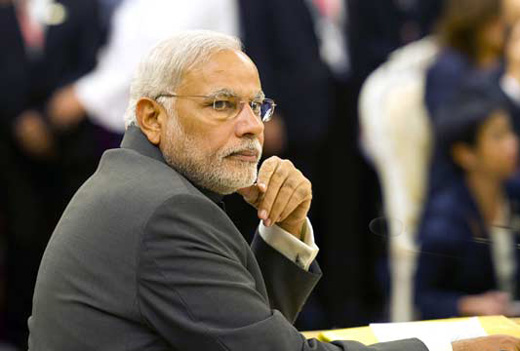PM Clears $8 Billion Plan For Warships to Counter China
mangaloretoday.com/ NDTV
New Delhi, Feb 18: The government has cleared an $8 billion or Rs. 50,000 crore plan to build India’s most advanced warships, defence sources said, just months after ordering new submarines to close the gap with the Chinese navy in the Indian Ocean.
Since taking over last year, Prime Minister Narendra Modi has signalled his resolve to build a strong military after years of neglect.
India’s navy has been rattled in recent months after Chinese submarines docked in Sri Lanka, just off its southern coast, underlining the growing reach of the Chinese navy after years of staying closer to its shores.

PM Modi summoned a meeting of the Cabinet Committee on Security on Monday to approve construction of seven frigates equipped with stealth features to avoid easy detection, a Defence Ministry source said.
The frigates, in a programme called Project-17A, will be built at government shipyards in Mumbai and Kolkata, in a boost for the PM’s ’Make in India’ campaign to build a domestic defence industrial base and reduce dependence on expensive imports, that have made India the world’s biggest arms market.
"Project 17-A was awaiting Cabinet clearance since 2012," the source said, adding the BJP government is moving quickly on a project seen as of critical national importance.
The source said the government expects to sign a contract with the shipyards within the month. Another source in the Navy confirmed the Cabinet clearance but said it would take a decade or even longer for all the ships to be built, even if the shipyards were to start construction immediately.
The Indian Navy’s undersea defences are down to 13 ageing diesel-electric submarines, after a string of accidents, including one in Mumbai in 2013 in which 18 sailors were killed.
In October, the government approved fast-tracking the tender process to build six submarines in collaboration with a foreign builder.
"This government is showing signs of urgency, but there is a lot of ground to be covered," said former Vice Admiral Arun Kumar Singh. "All our programmes are running way behind schedule and with a huge amount of cost over-runs."
- Former don Muthappa Rai’s son injured after being shot at in moving car near Bidadi house
- Mulki: Top portion of Bappanadu temple chariot collapses during Rathotsava; none hurt
- Belthangady youth slips to death in Cauvery river
- Kundapur: Speeding Omni fatally knocks down pedestrian
- Snehalaya and Janamaithri Police launch anti-Drug awareness drive at Uppal and Hosangadi
- Mangaluru: Fight will continue till amendments to Waqf Act are withdrawn, say Muslim leaders
- Direction to remove Janivara would have come with the knowledge of the govt., says Poojary
- JEE (Main) second edition results to be announced by April 19: NTA
- Three arrested for raping woman in Mangaluru, say police
- Summer rush: Special trains, Vande Bharat sleeper announced for Mangaluru
- Mangaluru: Yellow alert issued as thunderstorms expected across coastal Karnataka
- Mangaluru: Bride-to-be goes missing a day before wedding in Bolar
- Puttur: Grand Brahmarathotsav at Shri Mahalingeshwara Temple draws thousands with devotion and splendor
- Caste census report politically motivated, says R Ashoka
- PM Modi to visit Saudi Arabia from April 22-23
- 4 dead, many feared trapped as building collapses in Delhi’s Mustafabad
- Kerala teacher acquitted as student confesses fake rape allegation
- CET officials booked for asking students to remove sacred thread at exam centre in Shivamogga
- BJP worker found hanging in Bengaluru outskirts, video message names ‘local leader’
- CET row: Karnataka govt orders probe after students asked to remove sacred thread
- Man who flashed woman, assaulted 7 people arrested in Bengaluru
- FIR against Sunny Deol, Randeep Hooda for offending Christian religious sentiments in Jaat
- 22 maoists surrender before security forces in Chhattisgarh’s Sukma
- Indian Embassy repatriates 4 nationals scammed in Myanmar’s Myawaddy
- ED debunks Bengaluru man’s claims of importing Rs 50-crore wolfdog
- Skills and Competencies Take Center Stage at MSN Dialogue Series
- Court remands Maoist Lakshmi to six-day police custody
- Sandhya Shenoy honored with Society for Materials Chemistry Medal-2024
- White Cornus Apartment in Mangaluru
- City girl wins first place in state-level spell bee competition
- Alleged ‘Love Jihad’ Case in Mangaluru: Woman left home voluntarily, says police
- Girl fatally struck by reckless two-wheeler near Belman
- New residential complex for the judges inaugurated in Mangaluru
- Absconding accused nabbed after 8 years
- Truck with cylinders turns turtle in Beltangady
- Bhoota Kola artist dies of cardiac arrest
- Development of the country should be our goal: Ganesh Karnik
- Container truck gets stuck under Modankap railway bridge
- Truck crushes bike’s pillion rider near BC Road
- Head constable dies of heart attack
- CITY INFORMATION
- TRAVEL
- TOURIST INFORMATION
- HEALTH CARE
- MISCELLANEOUS




 Write Comment
Write Comment E-Mail To a Friend
E-Mail To a Friend Facebook
Facebook Twitter
Twitter  Print
Print 


